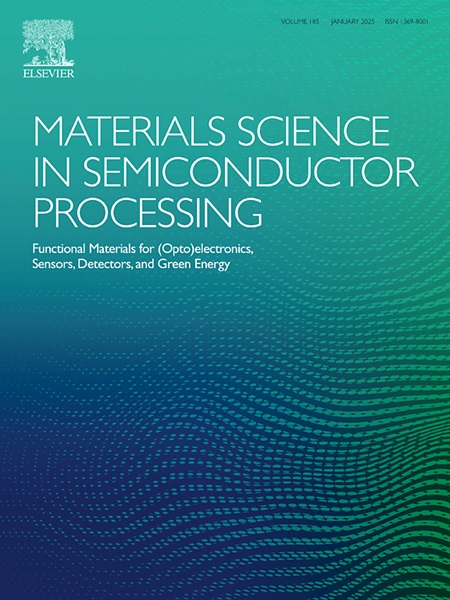基于金属-有机骨架衍生双金属碲化物/还原氧化石墨烯复合材料的高性能非对称超级电容器的制备
IF 4.6
3区 工程技术
Q2 ENGINEERING, ELECTRICAL & ELECTRONIC
引用次数: 0
摘要
对更高效的储能装置的需求导致了对具有前景的新型化合物的开发研究。在这方面,金属有机框架(MOFs)衍生的金属硫族化合物代表了一类新兴的活性材料,具有解决超级电容器技术关键挑战的潜力。在本研究中,我们首次开发了一种新型电极材料Ni-Zn-Te/rGO,该材料来源于泡沫镍(NF)上的MOF。Ni-Zn-Te/rGO/NF电极在2A g−1电流密度下具有265 mA h g−1 (1664 F g−1)的高比容量。值得注意的是,在7000次充放电循环后,它仍保持了94%的初始容量,表明它具有出色的循环稳定性。该电极进一步用于不对称超级电容器(ASC)配置,活性炭作为负极在水电解质中使用。在1442 W kg−1和2 a g−1的功率和电流密度下,组装的ASC的电位窗口、比容量和能量密度分别为1.7 V、98 mA h g−1 (194 F g−1)和77.9 W h kg−1。此外,该设备在7000次循环后仍能保持90%的初始容量,表现出出色的长期稳定性。该研究为高性能非对称超级电容器的高效耐用电极的设计和开发提供了一个有前途的策略。本文章由计算机程序翻译,如有差异,请以英文原文为准。
Fabrication of high-performance asymmetric supercapacitors based on metal-organic framework-derived bi-metallic telluride / reduced graphene oxide composites
Demand for more efficient energy storage devices has led to the research regarding the development of novel compounds with promising properties. In this regard, metal-organic frameworks (MOFs) derived metal chalcogenides represent an emerging class of active materials with the potential to address key challenges in supercapacitor technology. For the first time, in this study, we developed a novel electrode materials Ni-Zn-Te/rGO derived from MOF on nickel foam (NF). The Ni-Zn-Te/rGO/NF electrode demonstrated a high specific capacity of 265 mA h g−1 (1664 F g−1) at a current density of 2A g−1. Remarkably, it retained 94 % of its initial capacity after 7000 charge-discharge cycles, indicating its excellent cycling stability. The electrode was further utilized in an asymmetric supercapacitor (ASC) configuration with activated carbon as the negative electrode in an aqueous electrolyte. The assembled ASC showed a potential window, specific capacity, and energy density of 1.7 V, 98 mA h g−1 (194 F g−1), and 77.9 W h kg−1, respectively, at power and current density of 1442 W kg−1 and 2 A g−1, respectively. Additionally, the device retained 90 % of its initial capacity after 7000 cycles, demonstrating outstanding long-term stability. This research provides a promising strategy for the design and development of efficient and durable electrodes for high-performance asymmetric supercapacitors.
求助全文
通过发布文献求助,成功后即可免费获取论文全文。
去求助
来源期刊

Materials Science in Semiconductor Processing
工程技术-材料科学:综合
CiteScore
8.00
自引率
4.90%
发文量
780
审稿时长
42 days
期刊介绍:
Materials Science in Semiconductor Processing provides a unique forum for the discussion of novel processing, applications and theoretical studies of functional materials and devices for (opto)electronics, sensors, detectors, biotechnology and green energy.
Each issue will aim to provide a snapshot of current insights, new achievements, breakthroughs and future trends in such diverse fields as microelectronics, energy conversion and storage, communications, biotechnology, (photo)catalysis, nano- and thin-film technology, hybrid and composite materials, chemical processing, vapor-phase deposition, device fabrication, and modelling, which are the backbone of advanced semiconductor processing and applications.
Coverage will include: advanced lithography for submicron devices; etching and related topics; ion implantation; damage evolution and related issues; plasma and thermal CVD; rapid thermal processing; advanced metallization and interconnect schemes; thin dielectric layers, oxidation; sol-gel processing; chemical bath and (electro)chemical deposition; compound semiconductor processing; new non-oxide materials and their applications; (macro)molecular and hybrid materials; molecular dynamics, ab-initio methods, Monte Carlo, etc.; new materials and processes for discrete and integrated circuits; magnetic materials and spintronics; heterostructures and quantum devices; engineering of the electrical and optical properties of semiconductors; crystal growth mechanisms; reliability, defect density, intrinsic impurities and defects.
 求助内容:
求助内容: 应助结果提醒方式:
应助结果提醒方式:


